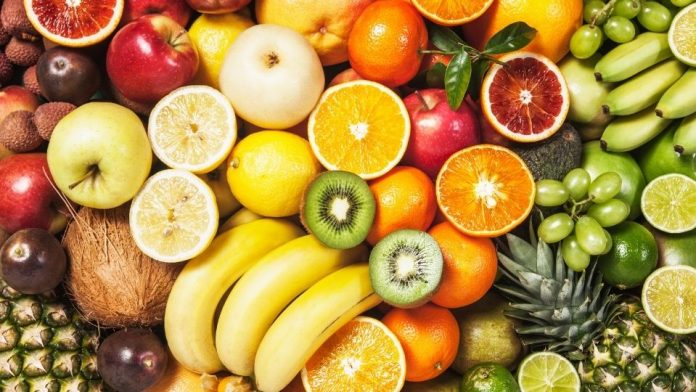You should include a variety of fruits in your daily diet. How to choose a variety of fruits? How much should you eat in a day? Let us talk about it in this guide.
Key Recommendations
- Variety: Include a variety of fruits. Variety is key to health and maintaining the balance of dosha and nutrients in the body. Eat at least 2-3 different fruits daily. Choose fruits from different fruit categories.
- Local and Seasonal: Choose fruits that are local and seasonal and widely available and grown in your country.
- Include Berries: Berries are essentially important. You should try to include berries in your daily fruit plate. Find your native berries if not listed in this guide.
- Ripe and Uncooked: Eat moderately ripe fruits, which are not processed, cooked or combined with other foods groups (except non-starchy vegetables).
Recommended Fruit Servings
You should consider your appetite, tolerance and metabolism to check how much you can eat and digest. According to the food plate principle, 25% should be fruits. It means 25% of your diet should consist of a variety of fruits.
We also provide a reference for a recommended fruit amount according to age below.
Standard Serving Size
| Fruit Form | 1 Serving Size equal to: |
| Fresh Fruits (except berries) | 150 grams |
| Dried Fruits * | 30 grams |
| Dried Berries | 40 grams |
| Fresh and Frozen Berries | 75 grams |
| Fruit Powder ** | 15 grams |
| Fruit Strap (Dehydrated Fruit Pulp) * | 30 grams |
* Dried Fruits include dried apricots, dates, prunes, figs, raisins, etc. You can take one serving of these dried fruits a day and only one serving of fruit strap a day. Choose other servings from the fresh fruits.
** We encourage fresh fruits. Fruit powder is not recommended. However, if you need to eat for supplementation or treat a specific disease, you should not take it more than 15 grams (one serving) a day. Choose other servings from the fresh fruits.
Daily Recommended Servings
The following table represents the serving size for fresh fruits:
| Age Group (in years) | Minimum Daily Amount | Recommended Daily Amount |
| 1-2 | ½ serving (75 g) | 1 Serving (150 g) |
| 2-3 | 1 Serving (150 g) | 1 ½ Serving (225 g) |
| 4-8 | 1 ½ Serving (225 g) | 2 Servings (300 g) |
| 9-11 | 2 Servings (300 g) | 2 ½ Servings (375 g) |
| 12-13 | 2 Servings (300 g) | 3 Servings (450 g) |
| 14-18 | 3 Servings (450 g) | 4 Servings (600 g) |
| 19-50 | 3 Servings (450 g) | 5 Servings (750 g) |
| 51-70 | 3 Servings (450 g) | 5 Servings (750 g) |
| 70+ | 2 Servings (300 g) | 4 Servings (600 g) |
| Pregnant | 3 Servings (450 g) | 5 Servings (750 g) |
| Lactating | 3 Servings (450 g) | 5 Servings (750 g) |
- Minimum: The minimum daily amount refers to the required daily amount that you must eat each day. People eating 800 grams of fruits and vegetables every day have a lower risk of diseases. (reference) According to this scenario, 400 grams of fruits and 400 grams of vegetables are essential for an adult to have a healthy life.
- Recommended: The recommended daily amount refers to the amount recommended to get maximum healing benefits.
Whatever your diet plan – Healing Phase Diet, Stablizing Phase Diet or Preventing Phase Diet, you should take fruits as per the above-recommended daily amount. If you follow Healing Phase Diet and Stablizing Phase Diet, you must eat fruits in the recommended amount. You can eat more than the recommended amount, but it should not be less than the recommended amount.
Balancing Fruit Intake
You can take fruits in the following way to balance the optimum fruit intake.
| Groups | Recommended Daily Servings |
| Group 1 | 20% |
| Group 2 | 30-40% |
| Group 3 | 20% |
| Group 4 | 20-30% |
If you cannot eat fruits from each group daily, you should balance fruits servings over the week.
It is not mandatory to eat fruits from each fruit group daily. But it is important to eat fruits from each group every week. To simplify it, we recommend dividing fruit intake as follows and eat at two different timings of the day:
| Timings | Day 1 | Day 2 |
| 10:00 AM | Group 1 Fruits | Group 2 Fruits |
| 4:00 PM | Group 3 Fruits | Group 4 Fruits |
Fruit Categories
We divide fruits into 4 major groups:
- Group 1: Pomegranate, Guava & Berries.
- Group 2: Pome & Stone Fruits.
- Group 3: Citrus Fruits.
- Group 4: Topical, Grapes & All Other Fruits.
We divide fruits into 4 groups based on our food guide to include various fruits in your diet. You should try to eat at different fruits daily. We encourage eating fruits from the same group at a time (it is not mandatory).
You should try to maintain the balance of each fruit’s group on a weekly basis. However, it is not mandatory if fruits from a specific group are not available seasonally and locally in your area.
Group 1 (Pomegranate, Guava & Berries)
It is an essential fruit group. You should not skip it in your weekly diet. This group consists of pomegranate, guava and berries. These fruits have health-promoting benefits and maintain optimum health due to high antioxidant activities and certain phytochemicals. These fruits are good for heart, brain and overall health.
- Pomegranate
- Guava
- Berries
- Acai Berries
- Barberries
- Bilberries
- Blackberries
- Blueberries
- Cherries (all types)
- Concord Grapes
- Cranberries
- Goji Berries.
- Kumquats
- Loganberries
- Mulberries
- Raspberries (all types)
- Strawberries
If you cannot find local and native berries listed above, you should check local berries to include your diet.
Group 2 (Pome & Stone Fruits)
Like berries, this group is also important. You should include various local and native fruits from this group. In group 2, Pome and stone type of fruits are included:
Pome fruits
- All types of Apples.
- All types of Pears.
- Nashi (Asian pears).
- Quince (Cydonia oblonga).
Stone fruits
- Apricots
- Apriums
- Nectarines
- Peaches
- Plums
- Pluots
It is a concise list. All fruits that are considered pome and stone are included in this fruit group. You should choose fruits that are native and grown in your country.
Group 3 (Citrus Fruits)
You should eat at least one serving from the citrus fruits daily. If daily serving is not possible, you should keep the balance of total servings over the week.
- Bergamot Orange
- Bitter orange
- Citron
- Grapefruit
- Kaffir lime
- Key Lime
- Kumquat
- Lemon
- Lime
- Mandarins
- Orange
- Pomelo
- Sweet lime (Mosmi)
- Tangerine
- Yuzu
Group 4 (Topical, Grapes & All Other Fruits)
Tropical fruits (other than listed in other groups), grapes and all other fruits that are not part of berries, pome, stone and citrus fruits are included in this fruit group.
Tropical fruits
- Banana
- Mangoes
- Melons
- Passionfruit
- Pawpaw
- Pineapple
- Fresh olive
- Papaya
- Rambutan
Grapes
- Green grapes
- Red grapes
- Black grapes
Other Fruits
- Avocado
- Figs
- Kiwifruit (green kiwi, golden kiwi)
- White Sapote
- Lychee
- Logan
- Jackfruit
- Jaboticaba
- Sapodilla
All Remaining Fruits
That is not related to berries, citrus, pome, and stone fruit categories.
Consideration
Variety is key to health. You need to include a variety. Eating different fruits on a daily basis is not essential. But you should maintain a balance of total servings of each group every week.
For example, you can take group 1 and 3 on day 1, but you must eat in the recommended amount. In adults, you can eat 375 grams of group 1 and 375 grams of group 3. On the second day, you can eat 375 grams of group 2 and 375 grams of group 4. By doing this, you can maintain a balance of each fruit group over two days.
Alternatively, you can follow the guideline described under ‘Balancing Fruit Intake’ heading above choosing a percentage of each fruit group daily.
Incompatible Combinations
- Avoid fruits (except tomatoes) with grains and legumes.
- Avoid citrus fruits with sweet fruits, melons, and vegetables.
- Avoid lemon with cucumber and tomatoes.
- Avoid melons with starchy vegetables and grains. Melons are best to eat alone.
If you have any doubt, you can contact us. We will glad to help you.


